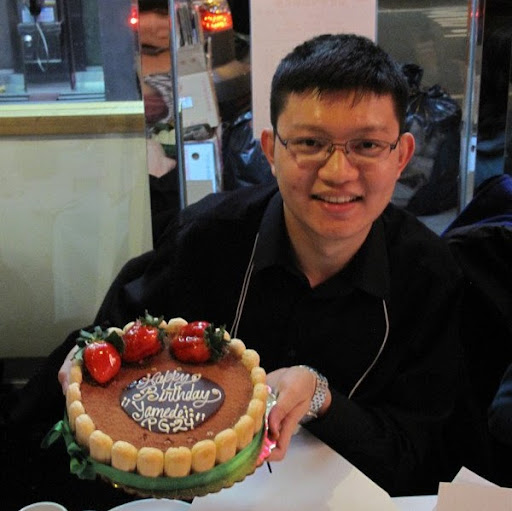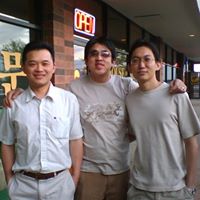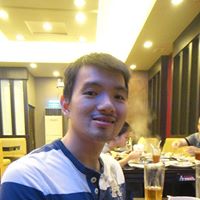Brian K Lu
age ~44
from Brooklyn, NY
Brian Lu Phones & Addresses
- Brooklyn, NY
- San Mateo, CA
- 36451 Dijon Dr, Newark, CA 94560
- 950 Linden St, Riverside, CA 92507
- San Jose, CA
- San Francisco, CA
Work
-
Company:Phi beta lambda-business organization - Berkeley, CAAug 2010
-
Position:Internal vice president
Education
-
School / High School:Albert Einstein College of Medicine of Yeshiva University1995
Languages
English
Awards
Healthgrades Honor Roll
Ranks
-
Certificate:Internal Medicine, 2003
Specialities
Oncology • Medical Oncology
Us Patents
-
Method Of Porogen Removal From Porous Low-K Films Using Uv Radiation
view source -
US Patent:7208389, Apr 24, 2007
-
Filed:Sep 26, 2003
-
Appl. No.:10/672311
-
Inventors:Adrianne K. Tipton - Fremont CA, US
Brian G. Lu - Fremont CA, US
Patrick A. Van Cleemput - Sunnyvale CA, US
Michelle T. Schulberg - Palo Alto CA, US
Qingguo Wu - Tualatin OR, US
Haiying Fu - West Linn OR, US
Feng Wang - Fremont CA, US -
Assignee:Novellus Systems, Inc. - San Jose CA
-
International Classification:H01L 21/76
-
US Classification:438409, 257E21273
-
Abstract:Methods of preparing a porous low-k dielectric material on a substrate are provided. The methods involve the use of ultraviolet radiation to react with and remove porogen from a porogen containing precursor film, leaving a porous low-k dielectric matrix. Methods using oxidative conditions and non-oxidative conditions are described. The methods described may be used to remove porogen from porogen-containing precursor films. The porogen may be a hydrocarbon such as a terpene (e. g. , alpha-terpinene) or a norbornene (e. g. , ENB). The resulting porous low-k dielectric matrix can then be annealed to remove water and remaining silanols capped to protect it from degradation by ambient conditions, which methods will also be described.
-
Cvd Flowable Gap Fill
view source -
US Patent:7629227, Dec 8, 2009
-
Filed:Oct 26, 2007
-
Appl. No.:11/925514
-
Inventors:Feng Wang - Fremont CA, US
Victor Y. Lu - Santa Cruz CA, US
Brian Lu - Fremont CA, US
Nerissa Draeger - Milpitas CA, US -
Assignee:Novellus Systems, Inc. - San Jose CA
-
International Classification:H01L 21/76
-
US Classification:438452, 257E21559
-
Abstract:Methods of lining and/or filling gaps on a substrate by creating flowable silicon oxide-containing films are provided. The methods involve introducing vapor-phase silicon-containing precursor and oxidant reactants into a reaction chamber containing the substrate under conditions such that a condensed flowable film is formed on the substrate. The flowable film at least partially fills gaps on the substrates and is then converted into a silicon oxide film. In certain embodiments, the methods involve using a catalyst, e. g. , a nucleophile or onium catalyst, in the formation of the film. The catalyst may be incorporated into one of the reactants and/or introduced as a separate reactant. Also provided are methods of converting the flowable film to a solid dielectric film. The methods of this invention may be used to line or fill high aspect ratio gaps, including gaps having aspect ratios ranging from 3:1 to 10:1.
-
Method Of Forming Low-Temperature Conformal Dielectric Films
view source -
US Patent:7678709, Mar 16, 2010
-
Filed:Jul 24, 2007
-
Appl. No.:11/881005
-
Inventors:Brian Lu - Fremont CA, US
Collin Mui - Mountain View CA, US
Bunsen Nie - Fremont CA, US
Raihan Tarafdar - San Jose CA, US -
Assignee:Novellus Systems, Inc. - San Jose CA
-
International Classification:H01L 21/31
H01L 21/469 -
US Classification:438769, 257703, 257752
-
Abstract:A deposition method modulates the reaction rate and thickness of highly conformal dielectric films deposited by forming a saturated catalytic layer on the surface and then exposing the surface to silicon-containing precursor gas and a reaction modulator, which may accelerate or quench the reaction. The modulator may be added before, after, or during exposure of the silicon-containing precursor gas. The film thickness after one cycle of deposition may be increased up to 20 times or decreased up to 20 times.
-
Density Gradient-Free Gap Fill
view source -
US Patent:7888273, Feb 15, 2011
-
Filed:Aug 6, 2007
-
Appl. No.:11/834581
-
Inventors:Feng Wang - Fremont CA, US
Victor Y. Lu - Santa Cruz CA, US
Brian Lu - Fremont CA, US -
Assignee:Novellus Systems, Inc. - San Jose CA
-
International Classification:H01L 21/31
H01L 21/469 -
US Classification:438778, 438781
-
Abstract:Multi-cycle methods result in dense, seamless and void-free dielectric gap fill are provided. The methods involve forming liquid or flowable films that partially fill a gap, followed by a solidification and/or anneal process that uniformly densifies the just-formed film. The thickness of the layer formed is such that the subsequent anneal process creates a film that does not have a density gradient. The process is then repeated as necessary to wholly or partially fill or line the gap as desired. The methods of this invention may be used to line or fill high aspect ratio gaps, including gaps having aspect ratios greater than about 6:1 with widths less than about 0. 13 μm.
-
Cluster Tool Architecture For Processing A Substrate
view source -
US Patent:8146530, Apr 3, 2012
-
Filed:Oct 20, 2008
-
Appl. No.:12/254778
-
Inventors:Tetsuya Ishikawa - Saratoga CA, US
Rick J. Roberts - San Jose CA, US
Helen R. Armer - Cupertino CA, US
Leon Volfovski - Mountain View CA, US
Jay D. Pinson - San Jose CA, US
Michael Rice - Pleasanton CA, US
David H. Quach - San Jose CA, US
Mohsen S. Salek - Saratoga CA, US
Robert Lowrance - Los Gatos CA, US
John A. Backer - San Jose CA, US
William Tyler Weaver - Austin TX, US
Charles Carlson - Cedar Park TX, US
Chongyang Wang - San Jose CA, US
Jeffrey Hudgens - San Francisco CA, US
Harald Herchen - Los Altos CA, US
Brian Lu - Mountain View CA, US -
Assignee:Applied Materials, Inc. - Santa Clara CA
-
International Classification:B05C 13/02
C23C 14/00
H01L 21/67 -
US Classification:118503, 118500, 118 50, 414217, 41422205, 414936
-
Abstract:Embodiments generally provide an apparatus and method for processing substrates using a multi-chamber processing system (e. g. , a cluster tool) that has an increased system throughput, increased system reliability, substrates processed in the cluster tool have a more repeatable wafer history, and also the cluster tool has a smaller system footprint. Embodiments also provide for a method and apparatus that are used to improve the coater chamber, the developer chamber, the post exposure bake chamber, the chill chamber, and the bake chamber process results. Embodiments also provide for a method and apparatus that are used to increase the reliability of the substrate transfer process to reduce system down time.
-
Cluster Tool Architecture For Processing A Substrate
view source -
US Patent:8181596, May 22, 2012
-
Filed:Oct 20, 2008
-
Appl. No.:12/254750
-
Inventors:Tetsuya Ishikawa - Saratoga CA, US
Rick J. Roberts - San Jose CA, US
Helen R. Armer - Cupertino CA, US
Leon Volfovski - Mountain View CA, US
Jay D. Pinson - San Jose CA, US
Michael Rice - Pleasanton CA, US
David H. Quach - San Jose CA, US
Mohsen S. Salek - Saratoga CA, US
Robert Lowrance - Los Gatos CA, US
John A. Backer - San Jose CA, US
William Tyler Weaver - Austin TX, US
Charles Carlson - Cedar Park TX, US
Chongyang Wang - San Jose CA, US
Jeffrey Hudgens - San Francisco CA, US
Harald Herchen - Los Altos CA, US
Brian Lu - Mountain View CA, US -
Assignee:Applied Materials, Inc. - Santa Clara CA
-
International Classification:B05C 13/02
C23C 14/00
H01L 21/677 -
US Classification:118500, 118503, 118 50, 414217, 41422501, 414935, 414936
-
Abstract:An apparatus for processing substrates using a multi-chamber processing system (e. g. , a cluster tool) that has an increased system throughput, increased system reliability, a smaller system footprint, and a more repeatable wafer history. Embodiments provide for a cluster tool comprising first and second processing racks, each having two or more vertically stacked substrate processing chambers, a first robot assembly able to access the first processing rack from a first side, a second robot assembly able to access the first processing rack from a second side and the second processing rack from a first side, a third robot assembly able to access the second processing rack from a second side, and a fourth robot assembly able to access the first and second processing racks and to load substrates in a cassette.
-
Cvd Flowable Gap Fill
view source -
US Patent:8187951, May 29, 2012
-
Filed:Nov 24, 2009
-
Appl. No.:12/625468
-
Inventors:Feng Wang - Fremont CA, US
Victor Y. Lu - Santa Cruz CA, US
Brian Lu - Fremont CA, US
Nerissa Draeger - Fremont CA, US -
Assignee:Novellus Systems, Inc. - San Jose CA
-
International Classification:H01L 21/76
-
US Classification:438452, 257E21559
-
Abstract:Methods of lining and/or filling gaps on a substrate by creating flowable silicon oxide-containing films are provided. The methods involve introducing vapor-phase silicon-containing precursor and oxidant reactants into a reaction chamber containing the substrate under conditions such that a condensed flowable film is formed on the substrate. The flowable film at least partially fills gaps on the substrates and is then converted into a silicon oxide film. In certain embodiments, the methods involve using a catalyst, e. g. , a nucleophile or onium catalyst, in the formation of the film. The catalyst may be incorporated into one of the reactants and/or introduced as a separate reactant. Also provided are methods of converting the flowable film to a solid dielectric film. The methods of this invention may be used to line or fill high aspect ratio gaps, including gaps having aspect ratios ranging from 3:1 to 10:1.
-
Cluster Tool Architecture For Processing A Substrate
view source -
US Patent:8215262, Jul 10, 2012
-
Filed:Oct 20, 2008
-
Appl. No.:12/254784
-
Inventors:Tetsuya Ishikawa - Saratoga CA, US
Rick J. Roberts - San Jose CA, US
Helen R. Armer - Cupertino CA, US
Leon Volfovski - Mountain View CA, US
Jay D. Pinson - San Jose CA, US
Michael Rice - Pleasanton CA, US
David H. Quach - San Jose CA, US
Mohsen S. Salek - Saratoga CA, US
Robert Lowrance - Los Gatos CA, US
John A. Backer - San Jose CA, US
William Tyler Weaver - Austin TX, US
Charles Carlson - Cedar Park TX, US
Chongyang Wang - San Jose CA, US
Jeffrey Hudgens - San Francisco CA, US
Harald Herchen - Los Altos CA, US
Brian Lu - Mountain View CA, US -
Assignee:Applied Materials, Inc. - Santa Clara CA
-
International Classification:B05C 13/02
C23C 14/00
H01L 21/677 -
US Classification:118500, 118503, 118 50, 414217, 41422501, 414935, 414936
-
Abstract:Embodiments generally provide an apparatus and method for processing substrates using a multi-chamber processing system (e. g. , a cluster tool) that has an increased system throughput, increased system reliability, substrates processed in the cluster tool have a more repeatable wafer history, and also the cluster tool has a smaller system footprint. In one embodiment, a cluster tool for processing a substrate includes a first processing rack, a first robot assembly and a second robot assembly operable to transfer substrates to substrate processing chambers in the first processing rack, and a horizontal motion assembly. The horizontal motion assembly includes one or more walls that form an interior region in which a motor is enclosed. The one or more walls defining an elongated opening through which a robot support interface travels, the robot support interface supporting a robot of the horizontal motion assembly.
Name / Title
Company / Classification
Phones & Addresses
Manager
ABL REALTY LLC
192-37 Underhill Ave, Fresh Meadows, NY 11365
Resumes

Brian Lu
view source
Brian Dunlavey L U Dunlavey Lu
view source
Francis Lewis High School
view sourceWork:
Francis Lewis High School

Brian Lu
view source
Brian Lu
view sourceLocation:
United States

Brian Lu
view sourceLocation:
United States
Medicine Doctors

Dr. Brian D Lu, Westfield NJ - MD (Doctor of Medicine)
view sourceSpecialties:
Oncology
Medical Oncology
Medical Oncology
Address:
59 Unami Ter, Westfield, NJ 07090
Certifications:
Internal Medicine, 2003
Medical Oncology, 2006
Medical Oncology, 2006
Awards:
Healthgrades Honor Roll
Languages:
English
Education:
Medical School
Albert Einstein College of Medicine of Yeshiva University
Graduated: 1995
Albert Einstein College of Medicine of Yeshiva University
Graduated: 1995
Googleplus

Brian Lu
Lived:
Beijing, China
Madison, WI
New York, NY
Dallas, TX
Madison, WI
New York, NY
Dallas, TX
Education:
Columbia University - IEOR, University Of Wisconsin-madison - ISyE, Math, Peking University - Chemistry
Relationship:
In_a_relationship

Brian Lu
Education:
University of California, San Diego - Chemical Engineering
Tagline:
ΨχΩ AΣ Class S2K10

Brian Lu

Brian Lu

Brian Lu

Brian Lu

Brian Lu

Brian Lu
Youtube
Myspace
Flickr
Classmates

Brian Lu
view sourceSchools:
Robert Usher Collegiate High School Regina Afghanistan 2001-2005
Community:
Sheri Jones

Robert Usher Collegiate H...
view sourceGraduates:
Brian Lu (2001-2005),
Tre Wilk (1985-1989),
Sheldon Wilk (1985-1989),
Bobbi Hamann (1985-1989)
Tre Wilk (1985-1989),
Sheldon Wilk (1985-1989),
Bobbi Hamann (1985-1989)

University of California ...
view sourceGraduates:
Nicola Laughlin (1991-1993),
Brian Lu (1999-2004),
Robert Beltran (1997-2001),
Sophia Seto (2001-2005),
Lawrence Im (1993-1997),
Brent Wessberg (2003-2004)
Brian Lu (1999-2004),
Robert Beltran (1997-2001),
Sophia Seto (2001-2005),
Lawrence Im (1993-1997),
Brent Wessberg (2003-2004)

Brian Lu
view source
Brian Lu
view source
Brian Martinez Lu
view source
Brian Patrick Lu
view source
Brian Benedict Lu
view source
Brian Lu
view source
Brian Lu Brian Lu
view source
Brian Lu Brenner
view sourceGet Report for Brian K Lu from Brooklyn, NY, age ~44
![Brian Lu [B-Lu] - Starts with an E, ends with an E... Brian Lu [B-Lu] - Starts with an E, ends with an E...](https://i.ytimg.com/vi/O0aGzaYt74U/0.jpg)
![Brian Lu [B-Lu] - You belong with someone else (or... Brian Lu [B-Lu] - You belong with someone else (or...](https://i.ytimg.com/vi/kAW9_MXGcLE/0.jpg)


![Brian Lu [B-Lu] Into the night Brian Lu [B-Lu] Into the night](https://i.ytimg.com/vi/nEZCjFDKI8s/0.jpg)














